
EVN/JIVE Newsletter - Edition 64 January 2023
Welcome to the January 2023 issue of the EVN/JIVE Newsletter.
After two years of steering both the EVN Consortium Board and the JIVE Council, Tiziana Venturi (INAF, Italy) will hand over to two new chairs: Pablo de Vicente (Yebes, Spain) will take over as chair of the JIVE Council and Simon Garrington (Jodrell Bank, UK) will take over as chair of the EVN CBD. Leading both EVN and JIVE boards simultaneously was a major effort and we offer our sincere thanks to Tiziana for doing such an excellent job – over the last two years we have seen fantastic science output from the EVN and JIVE, including high impact results on FRBs and other transient phenomena; new capabilities and flexible new policies to support transient astronomy; and a clear and wide-ranging science vision presented in the VLBI20-30 document which Tiziana coordinated.
At the same time, we also have a change of the JIVE Director. Francisco "Paco" Colomer announced he was stepping down and the JIVE Council have appointed a new director who will start in January.
Paco has been the JIVE Director for 5 years and in that time he has rapidly built the European and global profile of JIVE, especially in his role as chair of the ERIC forum, by establishing the Global VLBI Alliance and in building links with future SKA-VLBI. Paco also led the EC RADIOBLOCKS proposal, which will support development of hardware and software from front-end receiver components, through digital processing and novel correlator designs, to new data analysis software platforms. This major €10M project will start work in March 2023. It is our pleasure to thank Paco for all his dedication, hard work and very significant achievements as JIVE Director and to wish him well in his new role in the Spanish Ministry of Science, working with science policy makers across the EU.
It is also our pleasure to welcome the new JIVE Director, prof Agnieszka (Aga) Słowikowska, currently Deputy Director of Research Infrastructures at Nicolaus Copernicus University, Torun, Poland. As well as her background in time domain astronomy and polarimetry, Aga has led the refurbishment of the 32-m EVN antenna at Torun, modernised their optical facilities, developed and commissioned new polarimetric instrumentation and she also chairs the board of the Opticon-RadioNet Pilot (ORP) EC project.
The ORP project supports various EVN activities, in particular the transnational access, as well as training schools which include VLBI, and strategic work to consider how collaborations such as the EVN can be supported by the EC in future. ORP had a successful mid-term review in October and a consortium meeting in late November (at the SKAO HQ at Jodrell Bank) which included significant discussion of the EVN as a model of European collaboration.
With all best wishes for the New Year,
Simon Garrington, EVN Consortium Board of Directors Chair

Observing proposals are invited for the European VLBI Network (EVN). Deadline: 1 February 2023, 16:00:00 UTC. The EVN facility is open to all astronomers. Astronomers with limited or no VLBI experience are particularly encouraged to apply for observing time. Student proposals are judged favorably. Support with proposal preparation, scheduling, correlation, data reduction and analysis can be requested from the Joint Institute for VLBI ERIC (JIVE). Check details of the call for proposals here.
EVN Support+ programme
JIVE/EVN has a pilot programme to provide extended support to teams new to the EVN, with little or no direct VLBI experience. This includes the scheduling of the VLBI run and the VLBI-specific parts of the data reduction (including a-priori amplitude calibration and fringe-fitting). Imaging, and the interpretation of the data is the responsibility of the team. We aim to support some standard VLBI projects, evaluated by the EVN Program Committee with the highest grades. See the call for proposals for more information. For further questions please contact the Chair of the EVN PC, Zsolt Paragi (evnpc@jive.eu).

Snapshot of a magnetohydrodynamic disk wind traced by water maser observations
Luca Moscadelli (INAF-Osservatorio Astrofisico di Arcetri, Italy) on behalf of co-authors of the paper

The formation of astrophysical objects of different nature and size, from black holes to gaseous giant planets, involves a disk-jet system, where the disk drives the mass accretion onto a central compact object and the jet is a fast collimated ejection along the disk rotation axis. Magnetohydrodynamic (MHD) disk winds (DW) (Blandford et al., 1982; Pudritz et al., 1983) have been proposed to account for the link between mass accretion and ejection, which is essential to ensure that the excess... Read More
Discovery of recurrent flares of 6.7 GHz methanol maser emission in Cepheus A HW2
Michał Durjasz, Marian Szymczak, Mateusz Olech and Anna Bartkiewicz (Nicolaus Copernicus University, Poland)
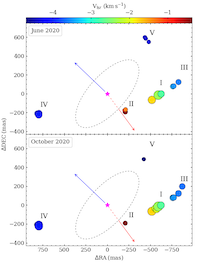
6.7 GHz methanol maser emission is one of the most important markers of high-mass star formation. It originates relatively close to the protostar (usually within 1000 AU) and is extremely sensitive to variations in the physical properties of the surrounding matter. Since all of the class II methanol masers (including 6.7 GHz transition) are considered to be pumped radiatively, they are often used as markers of protostellar activity, which was also the case in Cep A HW2. Cepheus A is a high-mass star-forming region located at a trigonometric distance of 700 pc that hosts a cluster of YSOs (young stellar objects). The brightest continuum source in this region is Cep A HW2, a high-mass protostar with a mass of ~10M⊙ that hosts bright 6.7 GHz methanol masers within 1000 AU. Cep A HW2 was observed on a 6.7 GHz transition by a 32 m antenna located in Piwnice near Toruń (Poland) with a typical cadence of 2 observations per month since June 2009. Single-dish observations revealed low-amplitude red-shifted flares that appeared in 2010, 2015, and 2020; additionally, we detected periods of increased activity of the most blue-shifted feature in 2012 and 2017. We decided to perform two epochs of the EVN observations to pinpoint cloudlets responsible or these phenomena: 06.2020 and 10.2020. Results revealed that flaring, red-shifted emission originates from the previously reported dust disc's edge. Comparison with older EVN observations revealed the detection of this emission also in 2015, which fully confirmed single-dish observations. Comparison with previous epochs also allowed us to find that blue-shifted emission ...Read More
A lensed radio jet at milli-arcsecond resolution I: Bayesian comparison of parametric lens models
Devon M. Powell (MPA, Germany), Simona Vegetti (MPA, Germany), J. P. McKean (Kapeteyn and ASTRON, the Netherlands), Cristiana Spingola (INAF, Italy), Hannah R. Stacey (MPA, Germany), Christopher D. Fassnacht (UC Davis, USA)

Strong gravitational lensing by galaxies is a powerful astronomical tool, as the lensing effect is sensitive to the total surface mass density in the lens galaxy. This provides an observational window, independent from and complementary to light-based modelling, into the complex physical processes that shape the distribution of mass in galaxies. For instance, gravitational lensing... Read More
Resolving the 3D structure of RS Oph, the fastest repeater among symbiotic recurrent-novae
by Ulisse Munari (INAF Padova, Italy), Marcello Giroletti (INAF Bologna, Italy), Benito Marcote (JIVE, the Netherlands), Tim J. O’Brien (Jodrell Bank, UK), Péter Veres (CSPAR, USA), Jun Yang (Chalmers Univ. Onsala, Sweden), David R. A. Williams (Jodrell Bank, UK), and Patrick Woudt (Univ. Cape Town, RSA)
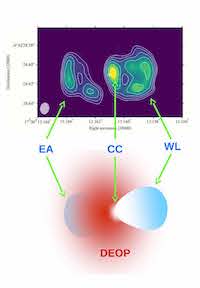
An EVN monitoring campaign of the 2021 outburst of the symbiotic recurrent nova RS Oph, in combination with high-resolution ground-based spectroscopy and the accurate astrometric position by Gaia, has allowed us to derive an unprecedented 3D view of the pre-existing circumstellar environment and of the nova ejecta expanding through it: launched at an initial velocity >8000 km/s, the ejecta have been rapidly decelerated into a bipolar shape by the density-enhancement laying on the orbital plane, with strong non-thermal emission originating from the shock interface with the slow and thick wind of the red-giant (RG) companion to the erupting white dwarf (WD). A nova eruption is rather violent, with 10-6 to 10-4 M⊙ of material being expelled at high velocity (103 km/s), as consequence of a thermonuclear runaway (TNR) igniting in the accreted and electron-degenerate shell of a white dwarf (WD). The binary system survives unscathed the eruption, and shortly after it the donor companion resumes transferring material to the WD. The refuelling time to the next eruption stretches over various orders of magnitudes, reaching the shortest recurrence times for the most massive WD accreting from cool giant companions (which are powerful mass-loser). Such kind of binary is known as "symbiotic", and RS Oph is undoubtedly... Read More

Agnieszka Słowikowska appointed as new JIVE Director
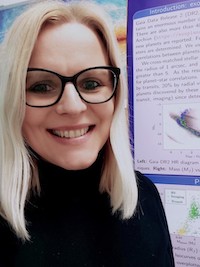
Agnieszka Słowikowska has been appointed as the next JIVE Director, to start in January 2023. Agnieszka (Aga) Słowikowska is currently Associate Professor, Institute of Astronomy, Faculty of Physics, Astronomy and Informatics, NCU (Poland). For the last three years she was the Deputy Director for Research Infrastructure of the Institute of Astronomy NCU. Among many international responsibilities, she is a member of the European VLBI Network Consortium Board of Directors as well as the current chair of the Opticon RadioNet Pilot project's Board. Aga is looking forward to taking the role of JIVE Director: "It is a great honour, and I am pleased that I was offered this position. It is a big challenge that I will meet with the help of the JIVE Council and the help of an excellent JIVE team. I believe that my experience gained in recent years as the director of research infrastructure at the Institute of Astronomy at the Nicolaus Copernicus University in Torun is an excellent foundation for fulfilling the duties associated with this position". Aga Słowikowska will take over the position that Francisco (“Paco”) Colomer has held for the past five years. Colomer will move back to Spain where he will join the Spanish Ministry of Science and Innovation to work in the coordination of the Ministry's activities during the Spanish Presidency of the Council of the European Union in July-December 2023... Read More
Francisco “Paco” Colomer Farewell Message
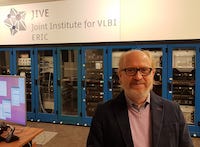
Dear colleagues, after almost 6 years in JIVE (5 as director), the time has come for me to step down and move to new projects. Coming to JIVE has been one of the best decisions of my life, it has allowed me to work with very talented people, in an intense international context. I learnt a lot. We engaged in many different activities which delivered together successfully, to highlight a few, the review in 2018, the EVN Science Vision 2020-2030, new correlator modes (multi-phase centers, pulsars, etc), enhanced user support (update of EVN users guide, EVN support+, ERIS and CASA-VLBI workshops, etc), many science and R&D projects, VLBI advocacy, etc... Read More
JIVE publishes its Gender Equality Plan

JIVE is committed to gender equality within its workforce as well as advocating its importance as part of its wider focus on equality, diversity and inclusion. The JIVE Gender Equality Plan (GEP) is a tool for sustainable change towards a fairer, safer, and more transparent work environment. The JIVE GEP consists of a display and analysis of the current state of actions at place, results of a gender-equality survey amongst JIVE employees, and an action plan to address issues highlighted by those assessments. Find the JIVE GEP here.
Solar eclipse with a radio telescope
Joni Tammi and Juha Kallunki (Metsähovi Radio Observatory, Finland)
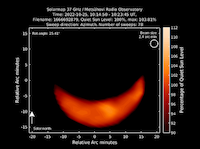
Northern Europe had front-row seats for the partial solar eclipse in October 2022. Unfortunately, the sky was overcast in most of Finland, and in most heavily populated southern cost it was raining the whole day. What a day to have a radio telescope! Aalto University Metsähovi Radio Observatory (MRO) in Kirkkonummi, southern Finland, has been monitoring the Sun at high radio frequencies since the late 1970s. The radome-enclosed 14-m radio telescope is used to create “radio maps” of the Sun by raster-scanning over the solar disk at 37 GHz frequency while recording the total flux density. The aim is to produce at least one solar radio map each day throughout the year. Solar observations are one of MRO’s three main observing modes, together with single-dish AGN monitoring and VLBI, and during the long northern summer days the Sun can be observed literally around... Read More
CASA on the fringe: processing of VLBI observations in CASA
Ilse van Bemmel, Mark Kettenis, Des Small and Marjolein Verkouter (JIVE, the Netherlands)
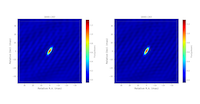
The Common Astronomy Software Applications (CASA) software package is now capable of calibrating the majority of VLBI observations. The new tasks and functionalities to process and calibrate VLBI observations - whose implementation has been led by JIVE - are described in a paper published in the Publications of the Astronomical Society of the Pacific (PASP) journal. In addition to a description of the software, a comparison with AIPS processing is included, demonstrating the results are of similar quality (as shown in the enclosed figure). This paper appears jointly with the new CASA reference paper, which gives... Read More
JUMPING JIVE VLBI comic available in English and French
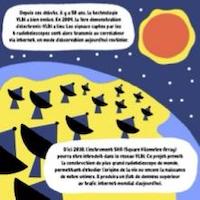
In the framework of the H2020 JUMPING JIVE project, CNRS commissioned a cartoon about VLBI that is now available in both English and French.
In the comic, two friends embark in a journey through space sparked by curiosity after seeing the first image of a black hole. In their journey, they learn about Very long Baseline Interferometry (VLBI), their applications, the European VLBI Network (EVN) and the Square Kilometre Array (SKA).

RADIOBLOCKS: A New European Consortium to develop Next Generation Technologies for Radio Astronomy Infrastructures
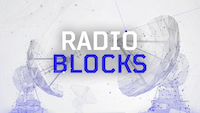
The RADIOBLOCKS project, coordinated by JIVE ERIC and including major European research infrastructures for radio astronomy, together with partners from industry and academia, have been granted 10 M€ by the European Commission to develop “common building blocks” for technological solutions beyond state-of-the-art, that will enable a broad range of new science and enhance European scientific competitiveness. The RADIOBLOCKS project will start on 1 March 2023...Read More
3.5 years of ESCAPE at JIVE - what's in it for our community?
Marjolein Verkouter, Des Small, Mark Kettenis, Aard Keimpema (JIVE, the Netherlands)
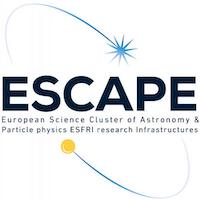
Over the past 3.5 years JIVE staff have spent their time developing several software components to integrate the European VLBI Network data, and the software to calibrate and analyse it, into the European Open Science Cloud (EOSC). All of this can be found at https://jupyterhub.jive.eu. This was made possible because of JIVE being a partner in the H2020 European Science Cluster of Astronomy and Particle Physics ESFRI Research Infrastructures (ESCAPE) project, a collaboration of the largest European astronomy and particle physics ESFRI landmarks (CTA, KM3Net, SKA) and pan-European research infrastructures such as CERN, ESO, and JIVE. The EOSC is part of the European Commission's vision on open science using FAIR data standards in a distributed European-wide framework. What this means is that data from European Research Infrastructures must be Findable, Accessible, Interoperable and Reusable. Within the EOSC, the software to process that data must also be openly available and guaranteed to meet certain minimum quality standards to make sure science results obtained with...Read More
ERIS 2022 School inspires a new generation of astronomers
Over 70 students from all over the world participated in the 9th European Radio Interferometry School (ERIS 2022) hosted by JIVE and ASTRON in Dwingeloo (the Netherlands) on 19-23 September 2022. The ERIS 2022 school - sponsored by the H2020 Opticon RadioNet Pilot (ORP) Project - provided a week of lectures and tutorials on how to achieve scientific results from radio interferometry. Over 20 tutors experts in radio astronomy and Very Long Baseline Interferometry (VLBI) provided different lectures and tutorials including introduction to interferometry; How to plan and propose for observations; Calibration and imaging of interferometry data; and Observing techniques with various arrays...Read More
Astronomers discuss future of Space VLBI in Dwingeloo
On 17-19 October 2022, JIVE and ASTRON co-hosted the 3rd Next Generation VLBI workshop (ngSVLBI-3) in Dwingeloo, the Netherlands. The hybrid workshop was attended both in-person and remotely by about 90 participants from all over the world. The ngSVLBI-3 workshop focused on the future of high-resolution radio interferometry in Space as a natural space-borne extension of advanced existing and prospective Earth-based facilities (Global VLBI, EHT and ngEHT, LOFAR) and Space VLBI missions VSOP and RadioAstron. The workshop programme covered all spectral domains from single-digit megahertz to terahertz. It included a posteriori reviews of the best interferometric achievements on the ground (LOFAR and other low-frequency...Read More
News from ORP

The Opticon RadioNet Pilot (ORP) is one of the European Commission's "pilot" programmes under the EC H2020, launched in March 2021. This four-year project brings together 37 institutions to support and develop seamless access to radio and optical facilities. Through various processes, ORP brings together radio and optical astronomers to create a stronger community to better exploit the opportunities of multi-wavelength science and benefit from each other's expertise. Find out about latest news of the project... Read More

- The SARAO / Breakthrough Listen MeerKAT Grand Tour Data Science Workshop, Makhanda, South Africa | 15-21 January 2023
- IAU Symposium (IAUS) 380 Cosmic Masers: Proper Motion toward the Next-Generation Large Projects, Kagoshima City, Japan & hybrid | 20-24 March 2023
- New Eyes on the Universe: SKA & ngVLA, Vancouver, Canada | 1-5 May 2023
- Bologna-VLBI: Life begins at 40! New frontiers and scientific challenges with enhanced frequency/time/space dynamic range, Bologna, Italy | 22-26 May 2023
- CASA VLBI Workshop 2023, Dwingeloo, the Netherlands | 5-9 June 2023
- European VLBI Group for Geodesy and Astrometry (EVGA) 26th Working Meeting, Bad Kötzting, Germany | 12-16 June 2023
- EAS 2023, Krakow, Poland | 10-14 July 2023
- URSI GASS 2023, Sapporo, Japan | 19-26 August 2023
- ALMA at 10 years: Past, Present, and Future, Puerto Varas, Chile | 4-8 December 2023
EVN/JIVE Newsletter Editorial Team: Francisco Colomer (JIVE Director, until 31 December 2022), Jorge Rivero González (JIVE Science Communications Officer, until 31 December 2022), Zsolt Paragi (JIVE Head of User Support) and Aukelien van den Poll (JIVE Finance and Project Officer).
For any enquiries about the newsletter, please contact communications@jive.eu.